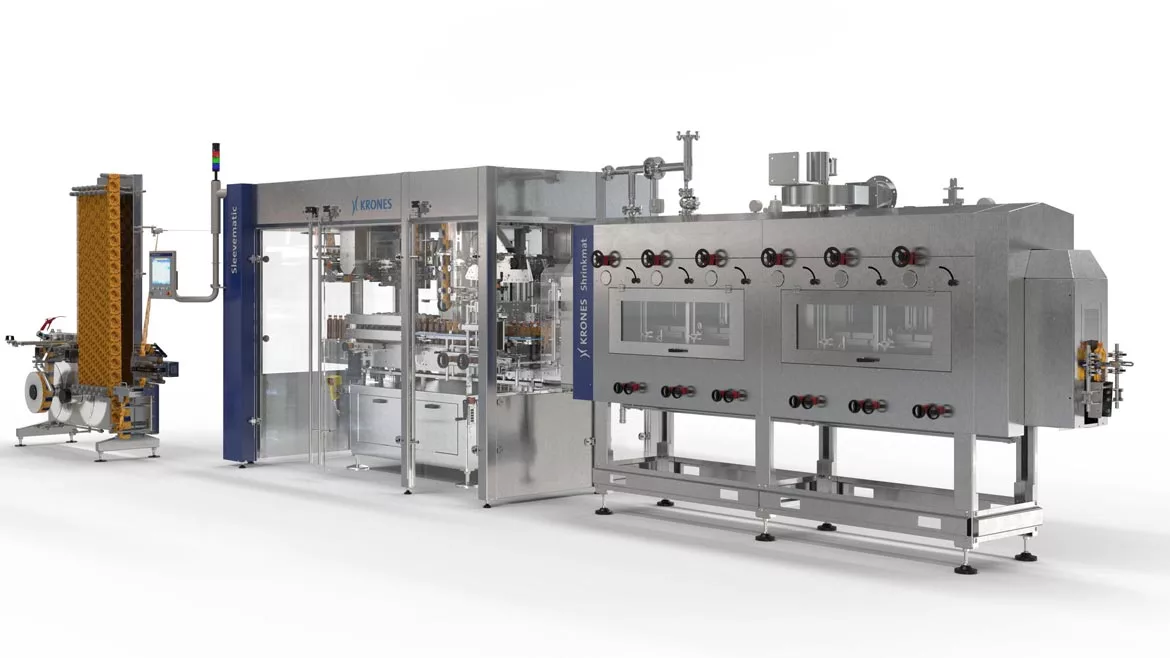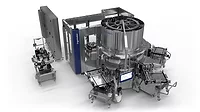Packaging Equipment
Labeling equipment suppliers adjust for beverage industry trends
Beverage-makers desire intelligent, high speed equipment

Image courtesy of Krones Inc.
In the animated film “The Emperor’s New Groove,” David Spade voices spoiled Emperor Kuczo, who is turned into a llama by his former advisor, Yzma. After being fired by the young emperor, Yzma is frustrated, so she plots to poison Kuzco and take over the empire before news gets out that she was fired. During a trip to her not-so-secret lair, Yzma’s henchman Kronk grabs the wrong vial, one that is labeled with the image of a llama. During dinner later that night Kuzco transforms into a llama.
If more advanced labeling technology had existed during the Incan empire, the movie would have had a much different outcome.
Although safety is a top priority when it comes to labeling, trends in beverage labeling materials — mainly sustainability — also are greatly impacting labeling equipment.
Mike Soloway, director of product sales, labeling technology for Franklin, Wis.-based Krones Inc., points to sustainability as the main driver for changes in equipment.
“Label manufacturers are focusing on developing products that can either be easily separated from the container during the recycling process or that can be recycled with the container,” he says. “These material and adhesive changes can lead to differences in the rigidity of the labels, which can affect how easily they can be applied to the container.”
Justin Slarks, director of marketing at Little Rock, Ark.-based Sleeve Seal, points to evolving packaging sizes as another factor impacting beverage labeling equipment.
“Small- and mid-sized containers have always been popular for shrink labeling,” he says. “It’s the XL formats that are starting to use shrink labels due to advances in XL format labelers. So, we are seeing protein-style tubs and 64-ounce or larger formats being run where this was rare not long ago.”
Krones’ Soloway notes that container sizes are only problematic when they are either too small to travel on a container without falling over, or too large to fit in an existing machine.
“What impacts equipment more than size is the shape of the container,” he explains. “Most labels require straight sides, since they cannot be applied to compound curves without some degree of wrinkling or bubbling. Shrink sleeves overcome the need for straight sides, but they can present challenges of their own.”
For example, shrink sleeve materials can only shrink up to a certain percentage, Soloway says, noting that container designs must take this into account.
“Also, shrink sleeve cannot shrink into recessed areas, such as pinch grips,” he explains. “Lastly, containers with flat tops, such as beverage cans, are more challenging, because the sleeve can hit the top of the can and bounce off as it is being applied, whereas a bottle with a gradual, sloping neck is more forgiving and can run through the sleever at a faster rate.”
As for packaging material trends impacting the industry, Soloway points to materials such as PETG, PVC and OPS. However, he notes that none of these materials are easily recycled.
“The two major approaches to addressing the issue of sleeve recyclability are floatable low-density polyolefin films and crystalized PET films,” he says. “Floatable films are increasing in popularity in Europe, but remain difficult to source in North America due to the limited amount of resin. During the recycling process, these sleeves float, while the heavier PET sinks.”
Soloway continues to explain how this allows the sleeve material to be removed, resulting in higher quality rPET flakes.
“Crystalized PET films are gaining traction in North America because they are more readily available. They are made from the same polymer as the PET bottles, so they can be recycled together without separation,” Soloway says. “However, special inks are required on these sleeves, because the ink must wash off during the recycling process.”
He notes that both technologies are fairly new, so tests are ongoing.
Sleeve Seal’s Slarks, points to floatable films as a promising option.
“We have been a part of many label trials, and have been successful running new variants of PET film,” he says. “‘Floatable’ film is a big topic in recyclability conversations, and it appears that there are no issues applying these new films at high speeds. We think that this will continue to grow in popularity and will continue to evolve.”
Finding the right fit
Beverage-makers often have certain requests when it comes to labeling and labeling equipment.
The most common request that Krones’ Soloway has noticed is for equipment that is high speed, with minimal downtime and operational efficiency.
“For example, Krones developed the Sleevematic TS, which provides high speed shrink sleeve labeling up to 50,000 containers per hour with just one labeling station,” he states. “Unlike other machines on the market, the Sleevematic TS cuts the sleeves in an ongoing movement and not in cycles, with a stop-and-go operation.”
Sleeve Seal’s Slarks notes that the company has seen pairs of mirrored labelers that each run at half speed.
This is so no production time is lost. If there is down time on one machine, production can be diverted to the other machine, he explains. Typically, only big manufacturers are putting such systems into place, he notes.
Meanwhile, Slarks says that the No. 1 complaint the company hears is that manufacturers do not have good operators.
“We design our systems to be as intelligent as possible and to minimize operator input,” he notes. “Efficiencies are up, cost of ownership is down, so our customers are happy.”
When looking to invest in labeling equipment, Slarks says that beverage-makers should consider various factors.
“The ability to grow a labeling system to other formats and faster speeds are good guidelines,” he shares. “Making a big buy to meet your current needs is shortsighted when faster, more adaptable machines are available for not much more cost.”
Krones’ Soloway’s advice is that labeling equipment should be easy to use and to maintain.
“Reducing the number of operator adjustment points will minimize downtown created by incorrectly adjusted components,” he says. “Twenty-four seven support with remote access capability and a large service network will result in faster error resolution to keep the equipment running at peak efficiency.”
As for the future of labeling equipment, Soloway suggests that better communication within machines is on the horizon. Improved communication, he notes, will “provide real-time diagnostics and error correction.”
“As controls develop, we think that machines will become easier to keep running at high speeds and will keep efficiencies high,” Sleeve Seal’s Slarks says. “We are marking very intelligent labelers at this time, so it will be interesting to see just how automated automation will become.”
Looking for a reprint of this article?
From high-res PDFs to custom plaques, order your copy today!







